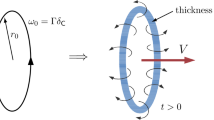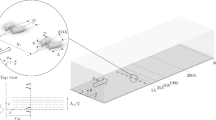Abstract
We have used a third-order essentially non-oscillatory method to obtain numerical shadowgraphs for investigation of shock–vortex interaction patterns. To search different interaction patterns, we have tested two vortex models (the composite vortex model and the Taylor vortex model) and as many as 47 parametric data sets. By shock–vortex interaction, the impinging shock is deformed to a S-shape with leading and lagging parts of the shock. The vortex flow is locally accelerated by the leading shock and locally decelerated by the lagging shock, having a severely elongated vortex core with two vertices. When the leading shock escapes the vortex, implosion effect creates a high pressure in the vertex area where the flow had been most expanded. This compressed region spreads in time with two frontal waves, an induced expansion wave and an induced compression wave. They are subsonic waves when the shock–vortex interaction is weak but become supersonic waves for strong interactions. Under a intermediate interaction, however, an induced shock wave is first developed where flow speed is supersonic but is dissipated where the incoming flow is subsonic. We have identified three different interaction patterns that depend on the vortex flow regime characterized by the shock–vortex interaction.
Similar content being viewed by others
References
Ffowcs W.J.E., Simson J., Virchis V.J.: ‘Crackle’: an annoying component of jet noise. J. Fluid Mech. 71, 251–271 (1975)
Chang S.-M., Chang K.-S., Lee S.: Reflection and penetration of shock wave interacting with a starting vortex. AIAA J. 42(4), 796–805 (2004)
Dosanjh D.S., Weeks T.M.: Interaction of a starting vortex as well as a vortex street with a traveling shock wave. AIAA J. 3, 216–223 (1965)
Weeks T.M., Dosanjh D.S.: Sound generation by shock-vortex interaction. AIAA J. 5, 660–669 (1967)
Ribner H.S.: Cylindrical sound wave generated by shock vortex interaction. AIAA J. 23, 1708–1715 (1985)
Ellzey J.L., Henneke M.R., Picone J.M., Oran E.S.: The interaction of a shock with a vortex: shock distortion and the production of acoustic waves. Phys. Fluid 7, 172–183 (1995)
Chang S.-M., Chang K.-S.: Visualization of shock-vortex interaction radiating acoustic waves. J. Vis. 3, 221–228 (2000)
Inoue O., Hattori Y.: Sound generation by shock-vortex interactions. J. Fluid Mech. 380, 81–116 (1999)
Grasso F., Pirozzoli S.: Shock-wave-vortex interactions: shock and vortex deformations and sound production. Theor. Comput. Fluid Dyn. 13, 421–456 (2000)
Shu C.W., Osher S.: Efficient implementation of essentially non-oscillatory shock-capturing schemes. J. Comput. Phys. 77, 439–471 (1988)
Shu C.W., Osher S.: Efficient implementation of essentially non-oscillatory shock-capturing schemes, ii. J. Comput. Phys. 83, 32–78 (1989)
Barik H., Chatterjee A.: Existence criteria for reflection configurations in shock-vortex interactions. Shock Waves 16, 309–320 (2007)
Author information
Authors and Affiliations
Corresponding author
Additional information
Communicated by B. W. Skews.
Rights and permissions
About this article
Cite this article
Chang, KS., Barik, H. & Chang, SM. The shock–vortex interaction patterns affected by vortex flow regime and vortex models. Shock Waves 19, 349–360 (2009). https://doi.org/10.1007/s00193-009-0210-1
Received:
Revised:
Accepted:
Published:
Issue Date:
DOI: https://doi.org/10.1007/s00193-009-0210-1




